Add this eBook to your basket to receive access to all 170 records. Our indexes include entries for the spelling kilpatrick. In the period you have requested, we have the following 170 records (displaying 131 to 140): These sample scans are from the original record. You will get scans of the full pages or articles where the surname you searched for has been found. Your web browser may prevent the sample windows from opening; in this case please change your browser settings to allow pop-up windows from this site. Medical Practitioners in the Provinces
(1926)
The Medical Directory was split into several sections. The Provinces section covered all medical practitioners resident in England outside the London postal district (except those in Monmouthsire, who were listed under Wales). Each year a schedule was sent to each doctor to be returned to the publishers, so as to keep the directory up to date. In the directory the doctor's name is given first, in bold, surname first, in capitals; then current address. Next are the qualifications; the italic abbreviations in parentheses following the qualifications indicate the medical school at which they were gained. Then there is a list of posts and honours within the profession, starting with those then current; previous posts are preceded by the word 'late'. Finally, brief details are given of any publications. | Sample scan, click to enlarge

| Boys entering Trinity College, Glenalmond
(1928)
Trinity College, Glenalmond, Perthshire, was originally founded as a college at which young men might be trained for the ministry of the Scottish Episcopal Church, and the sons of the laity might be educated and brought up in the faith and tradition of the Church. In 1876 the Theological College was transferred to Edinburgh, Glenalmond remaining as a boys' school. This second edition of the school register, edited by G. St Quintin, was published in 1955, incorporating the text of the first edition prepared by E. W. Neish. The scholars are listed by term of entering the school, and then alphabetically by surname; the details then given are full christian names, date of birth; name of father; any distinctions within the school; and then a career synopsis, with date and place of death where known. | Sample scan, click to enlarge
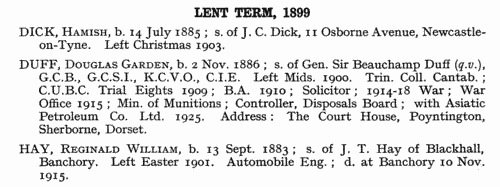
| Residents of Ayr: Blackburn Road (1928)
The Ayr street directory lists residents by street and then by house number.
| Sample scan, click to enlarge
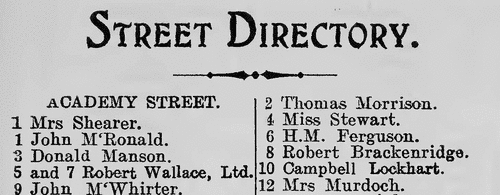
| Residents of Ayr: Monument Road (1928)
The Ayr street directory lists residents by street and then by house number.
| Sample scan, click to enlarge
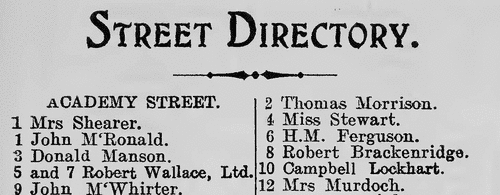
| Residents of Ayr: Newmarket Street (1928)
The Ayr street directory lists residents by street and then by house number.
| Sample scan, click to enlarge
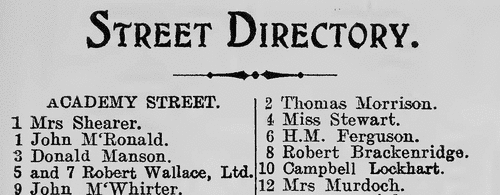
| Members of the Highland & Agricultural Society of Scotland: Ayr
(1931)
This list of the 9739 members of the Highland and Agricultural Society of Scotland was printed in 5th series, volume 43, of the society's Transactions. The list, which gives year of admission, full name (surname first) and address, is set out alphabetically by county and show division - Aberdeen, Angus (Eastern and Western districts), Argyll, Ayr, Banff, Berwick, Bute, Caithness, Clackmannan, Dumbarton, Dumfries, East Lothian, Fife, Inverness, Kincardine, Kinross, Kirkcudbright, Lanark, Mid-Lothian, Moray, Nairn, Orkney, Peebles, Perth (Perth and Stirling show districts), Renfrew, Ross & Cromarty, Roxburgh, Selkirk, Shetland, Stirling, Sutherland, West Lothian, and Wigtown, with separate sections for members living in England & Wales, Ireland, The Colonies and Foreign Countries. In addition, prior to 1900 holders of the Agricultural Diploma and the First-Class Certificate in Forestry had been eligible for free life membership, and those surviving are listed separately in an appendix. | Sample scan, click to enlarge

| Members of the Highland & Agricultural Society of Scotland: England and Wales
(1931)
This list of the 9739 members of the Highland and Agricultural Society of Scotland was printed in 5th series, volume 43, of the society's Transactions. The list, which gives year of admission, full name (surname first) and address, is set out alphabetically by county and show division - Aberdeen, Angus (Eastern and Western districts), Argyll, Ayr, Banff, Berwick, Bute, Caithness, Clackmannan, Dumbarton, Dumfries, East Lothian, Fife, Inverness, Kincardine, Kinross, Kirkcudbright, Lanark, Mid-Lothian, Moray, Nairn, Orkney, Peebles, Perth (Perth and Stirling show districts), Renfrew, Ross & Cromarty, Roxburgh, Selkirk, Shetland, Stirling, Sutherland, West Lothian, and Wigtown, with separate sections for members living in England & Wales, Ireland, The Colonies and Foreign Countries. In addition, prior to 1900 holders of the Agricultural Diploma and the First-Class Certificate in Forestry had been eligible for free life membership, and those surviving are listed separately in an appendix. | Sample scan, click to enlarge

| Scientific Poultry Breeders
(1932)
The Scientific Poultry Breeders Association was by far the largest poultry society in Great Britain, with 16,109 members for the year 1930-1931. This seventeenth annual register, for the year 1932, lists members alphabetically by surname and initials, with addresses. P. F. stands for Poultry Farm. | Sample scan, click to enlarge

| Boys entering Sherborne School
(1934)
The grammar school at Sherborne in Dorset, which doubtless existed from the creation of the diocese of Sherborne in 705, was refounded by king Edward VI in 1550. At the quatercentenary in 1950, a fourth edition of the Sherborne Register was published, listing boys entering the school during those four centuries. In truth, the materials for this register survive but fitfully before 1823; for some years, no names are known; sometimes all that is known is a surname. But from 1823 onwards the lists and the details get steadily more comprehensive. By the 20th century the boys are listed alphabetically by surname under term of entrance. Surname is given in bold, then christian names, name of father (surname and initials) and address; year of birth; house (a, School House; b, Abbey House; c, The Green; d, Harper House (formerly The Retreat); f, Abbeylands; g, Lyon House; h, Westcott House); whether represented the school at cricket (xi), football (xv), shooting (viii), &c.; year of leaving; summary of degrees, career &c.; and (in italics), address as of 1950. Names in the early lists marked with an asterisk are found inscribed on the oak panelling or on the stone walls of the former schoolroom. (F) in the lists indicates a foundationer, receiving free education: after 1827, when this privilege was restricted to boys from Sherborne and neighbourhood, nearly all foundationers were day-boys. | Sample scan, click to enlarge
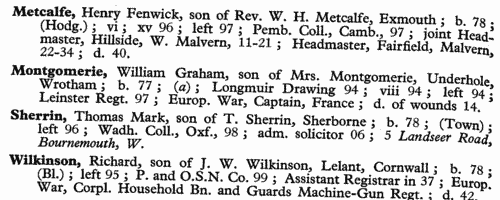
| Boys entering Sherborne School
(1935)
The grammar school at Sherborne in Dorset, which doubtless existed from the creation of the diocese of Sherborne in 705, was refounded by king Edward VI in 1550. At the quatercentenary in 1950, a fourth edition of the Sherborne Register was published, listing boys entering the school during those four centuries. In truth, the materials for this register survive but fitfully before 1823; for some years, no names are known; sometimes all that is known is a surname. But from 1823 onwards the lists and the details get steadily more comprehensive. By the 20th century the boys are listed alphabetically by surname under term of entrance. Surname is given in bold, then christian names, name of father (surname and initials) and address; year of birth; house (a, School House; b, Abbey House; c, The Green; d, Harper House (formerly The Retreat); f, Abbeylands; g, Lyon House; h, Westcott House); whether represented the school at cricket (xi), football (xv), shooting (viii), &c.; year of leaving; summary of degrees, career &c.; and (in italics), address as of 1950. Names in the early lists marked with an asterisk are found inscribed on the oak panelling or on the stone walls of the former schoolroom. (F) in the lists indicates a foundationer, receiving free education: after 1827, when this privilege was restricted to boys from Sherborne and neighbourhood, nearly all foundationers were day-boys. | Sample scan, click to enlarge
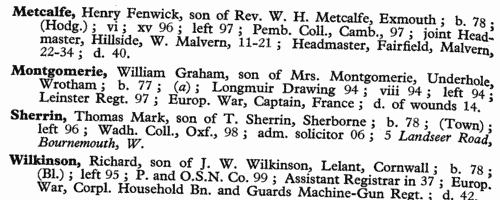
|
Research your ancestry, family history, genealogy and one-name study by direct access to original records and archives indexed by surname.
|











